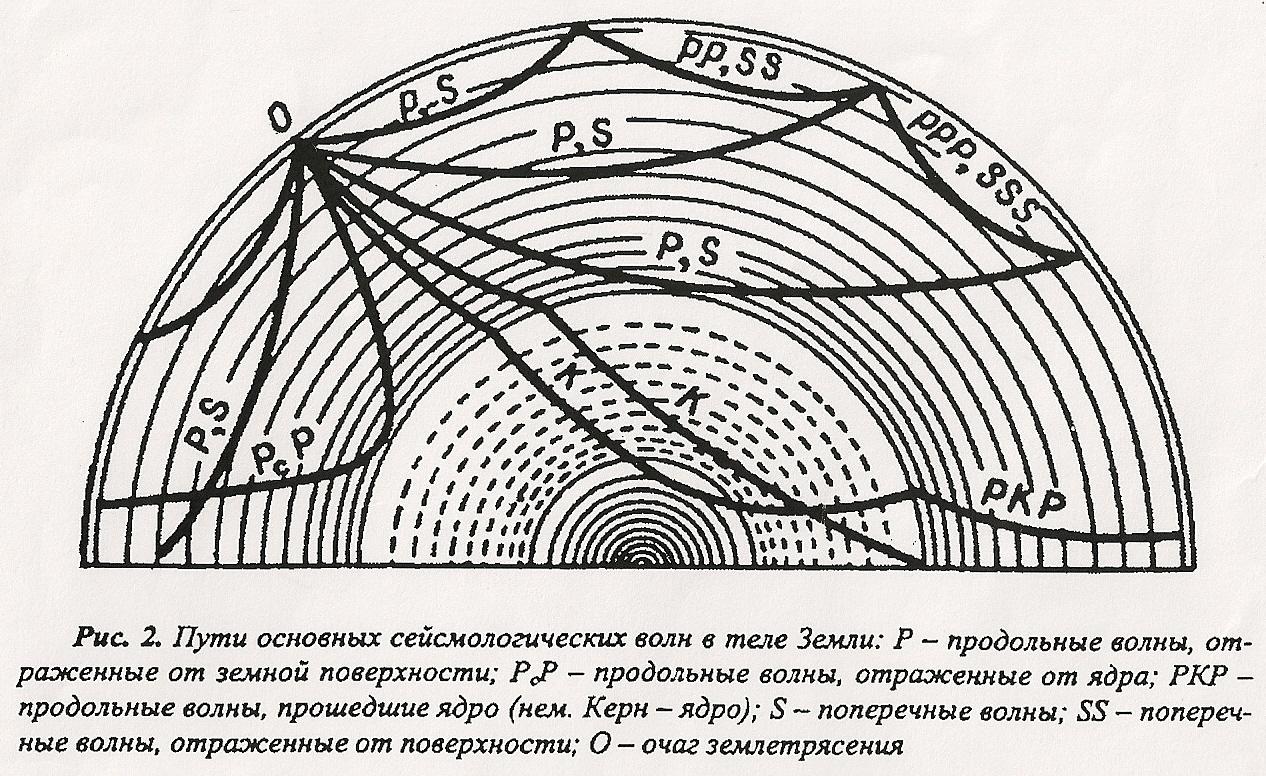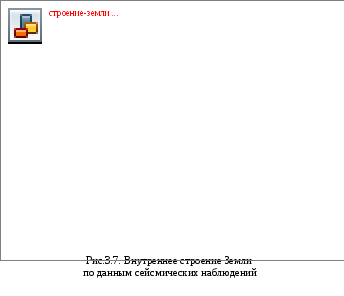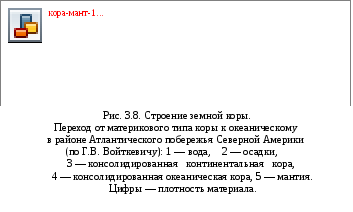The ideas about the internal heterogeneity of the Earth's structure and its concentric-zonal structure are based on the results of complex geophysical studies. Direct evidence of the deep structure of the earth's interior refers to shallow depths. They were obtained in the process of studying natural sections ( outcrops) rocks, cuts of quarries, mines and boreholes. The deepest well in the world on the Kola Peninsula went deep into the bowels of 12 kilometers. This is only 0.2% of the radius of the Earth (the radius of the Earth is about 6 thousand km.) (Fig. 3.5.). The products of volcanic eruptions make it possible to judge the temperatures and composition of matter at depths of 50-100 km.
Rice. 3.5. Inner shells of the earth
seismic waves. The main method of subsurface research is the seismic method. It is based on measuring the speed of passage of mechanical vibrations of various types through the Earth's substance. This process is accompanied by the release of a large amount of energy and the occurrence of mechanical vibrations that propagate in the form of seismic waves in all directions from the place of origin. The speed of propagation of seismic waves is very high and in dense bodies, for example, in stone (in rocks), it reaches several kilometers per second. There are two groups of seismic waves - voluminous and superficial(Fig. 3.6. and 3.7.). The rocks that make up the Earth are elastic and therefore can be deformed and oscillate when pressure (loads) is applied sharply. Body waves propagate inside the volume of rocks. They are divided into two types: longitudinal (P) and transverse (S) . Longitudinal waves in the body of the Earth (as in any other physical bodies) arise as a reaction to a change in volume. Like sound waves in the air, they alternately compress and stretch the material of rocks in the direction of their movement. Waves of another type - transverse ones arise as a reaction to a change in the shape of the body. They vibrate the medium they pass through across their path.
At the boundary of two media with different physical properties, seismic waves experience refraction or reflection (P, S, PcP, PkP, etc.). Geophysical studies were supplemented by thermodynamic calculations and the results of physical modeling and data from the study of meteorites.
The data obtained indicate the presence of numerous subhorizontal interfaces in the Earth's interior. At these boundaries, there is a change in the speeds and directions of propagation of physical waves (seismic, electromagnetic, etc.) as they propagate deep into the planet.

Rice. 3.6. Propagation of seismic waves (O - earthquake source).
These boundaries separate separate shells from each other - "geospheres", which differ from each other in chemical composition and in the state of aggregation of matter in them. These boundaries, by no means, represent the usual geometrically regular infinitely thin planes. Any of these boundaries is a certain volume of subsoil, relatively small compared to the volume of the geospheres to be separated. Within each such volume, there is a rapid but gradual change in the chemical composition and state of aggregation of the substance.
Bowels of the earth. According to existing ideas, the globe is divided into a number of concentric shells (geospheres), as if nested into each other (Fig. 3.7., Table 3.5.). "Outer" shells and "inner" shells (sometimes the latter are called simply "subsoil") are separated from each other by the surface of the earth. The inner shells are represented, respectively, by the core, the mantle and the earth's crust. Each of these geospheres, in turn, has a complex structure. The Gutenberg-Bullen model uses the indexing of geospheres, which is still popular today. The authors highlight: the earth's crust(layer A) - granites, metamorphic rocks, gabbro; upper mantle(layer B); transition zone(layer C); lower mantle(layer D), consisting of oxygen, silica, magnesium and iron. At a depth of 2900 km, a boundary is drawn between the mantle and the core. Below is outer core(layer E), and from a depth of 5120 m - inner core(layer G) folded with iron:
-
 Earth's crust
- thin outer stone shell of the Earth. It extends from the Earth's surface down to 35-75 km, layer A: Cf. thickness 6-7 km - under the oceans; 35-49 km - under the flat platform territories of the continents; 50-75 km - under the young mountain structures. It is the outermost of the inner shells of the Earth.
Earth's crust
- thin outer stone shell of the Earth. It extends from the Earth's surface down to 35-75 km, layer A: Cf. thickness 6-7 km - under the oceans; 35-49 km - under the flat platform territories of the continents; 50-75 km - under the young mountain structures. It is the outermost of the inner shells of the Earth.
mantle - intermediate shell (35-75 km. up to 2900 km) (layers B, C, D) (Greek “mantion” - cover): layers B (75-400 km) and C (400-1000 km) correspond to the upper mantle ; transitional layer D (1000-2900 km) - lower mantle.
-core - (2900 km. - 6371 km.) layers E, F, G where: E (2900-4980 km) - outer core; F (4980-5120 km) - transitional shell; G (5120-6371 km) is the inner core.
Earth's core . The core makes up 16.2% of its volume and 1/3 of its mass. It is apparently compressed at the poles by 10 km. At the boundary between the mantle and the core (2900 km), there is an abrupt decrease in the velocity of longitudinal waves from 13.6 to 8.1 km/s. Shear waves below this interface do not penetrate. The core does not pass them through itself. This gave reason to conclude that in the outer part of the nucleus the substance is in a liquid (molten) state. Below the boundary between the mantle and the core, the velocity of longitudinal waves increases again - up to 10.4 km/s. At the boundary of the outer and inner core (5120 km), the velocity of longitudinal waves reaches 11.1 km/s. And then to the center of the Earth almost does not change. On this basis, it is assumed that from a depth of 5080 km, the substance of the core again acquires the properties of a very dense body, and a solid internal " nucleolus"with a radius of 1290 km. According to some scientists, the earth's core consists of nickel iron. Others argue that iron, in addition to nickel, contains an admixture of light elements - silicon, oxygen, possibly sulfur, etc. In any case, iron, as a good conductor of electricity, can serve as a source of the dynamo effect and the formation of the Earth's magnetic field.
Indeed, from the point of view of physics, the Earth, in some approximation, is a magnetic dipole, i.e. a kind of magnet with two poles: south and north.
Japanese scientists prove that the core of the Earth is gradually increasing due to the differentiation of the mantle substance 12 . makes up 82.3% of the Earth's volume. Only hypothetical assumptions can be made about its structure and material composition. They are based on seismological data and materials of experimental modeling of physical and chemical processes occurring in the depths at high pressures and temperatures. The velocity of longitudinal seismic waves in the mantle increases up to 13.6 km/s, transverse - up to 7.2-7.3 km/s.
Mantle of the Earth (upper and lower). Below the Mohorovichic section between the Earth's crust and the Earth's core is mantle(down to a depth of about 2900 km). This is the most massive of the Earth's shells - it makes up 83% of the Earth's volume and about 67% of its mass. In the mantle of the Earth, according to the structure, composition and properties, three layers are distinguished: Gutenberg layer - B to a depth of 200–400 km, Galicin layer - C up to 700-900 km and layer D up to 2900 km. As a first approximation, layers B and C are usually combined into the upper mantle, and the layer D considered as the lower mantle. In general, within the mantle, the density of matter and the velocity of seismic waves increase rapidly.
Upper mantle. It is believed that the upper mantle is composed of igneous rocks, strongly depleted in silica, but enriched in iron and magnesium (the so-called ultramafic rocks), mainly peridotite. Peridotite consists of 80% of the mineral olivine (Mg,Fe) 2 and 20% of pyroxene (Mg,Fe) 2 .
Earth's crust differs from the underlying shells in its structure and chemical composition. The sole of the earth's crust is delineated by the seismic Mohorovichic boundary, on which the propagation velocities of seismic waves increase sharply and reach 8 - 8.2 km/s.
Table 3.5. The prevalence of rocks in the earth's crust
(according to A.B. Ronov, A.A. Yaroshevsky, 1976. and according to V.V. Dobrovolsky, 2001)
|
Breed groups |
Prevalence, % of the volume of the earth's crust |
Weight, 10 18 t |
|
|
Sands and sand rocks | |||
|
Clays, shales, siliceous rocks | |||
|
Carbonates | |||
|
Salt deposits (sulphate and halide rocks) | |||
|
Granitoids, granite gneisses, felsic effusives and their metamorphic equivalents | |||
|
Gabbro, basalts and their metamorphic equivalents | |||
|
Dunites, peridotites, serpentinites | |||
|
Metasandstones | |||
|
Paragneisses and schists | |||
|
Metamorphosed carbonate rocks | |||
|
ferruginous rocks | |||
The earth's surface and approximately 25 km of the earth's crust are formed under the influence of:
1)endogenous processes(tectonic or mechanical and magmatic processes), due to which the relief of the earth's surface is created and strata of igneous and metamorphic rocks are formed;
2) exogenous processes, causing denudation (destruction) and leveling of the relief, weathering and transfer of rock fragments and their redeposition in the lower parts of the relief. As a result of the occurrence of very diverse exogenous processes, sedimentary rocks are formed that make up the uppermost layer of the earth's crust.
There are two main types of the earth's crust: continental(granite-gneiss) and ocean(basalt) with a discontinuous sedimentary layer. The transition from the continental-type crust to the oceanic-type crust is shown in fig. 3.8.
There are three layers in the continental crust: upper- sedimentary and two lower composed of crystalline rocks. The thickness of the upper sedimentary layer varies over a wide range: from almost complete absence on ancient shields to 10 - 15 km on the shelves of the passive margins of the continents and in the marginal troughs of the platforms. The average thickness of precipitation on stable platforms is about 3 km.
Beneath the sedimentary layer are strata dominated by igneous and metamorphic rocks of the granitoid series, relatively rich in silica. In places in the areas where ancient shields are located, they come to the earth's surface (Canadian, Baltic, Aldan, Brazilian, African, etc.). The rocks of the "granite" layer are usually transformed by the processes of regional metamorphism and are very old (80% of the continental crust is older than 2.5 billion years).
P  Under the "granite" layer is the "basalt" layer. Its material composition has not been studied, but judging by the data of geophysical studies, it is assumed that it is close to the rocks of the oceanic crust.
Under the "granite" layer is the "basalt" layer. Its material composition has not been studied, but judging by the data of geophysical studies, it is assumed that it is close to the rocks of the oceanic crust.
Both continental and oceanic crust are underlain by rocks of the upper mantle, from which they are separated by the Mohorovichic boundary (Moho boundary).
In general, the Earth's crust consists mainly of silicates and aluminosilicates. It is dominated by oxygen (43.13%), silicon (26%) and aluminum (7.45%), mainly in the form of oxides, silicates and aluminosilicates. The average chemical composition of the earth's crust is given in Table. 3.6.
In the earth's crust of the continental type, there is a relatively high content of long-lived radioactive isotopes of uranium 238 U, thorium 232 Th and potassium 40 K. Their highest concentration is characteristic of the "granite" layer.
|
Table 3.6. Average chemical composition of continental and oceanic crust |
||
|
Oxides and Dioxides | ||
|
continental |
oceanic |
|
The uppermost layer - sedimentary - is represented by sandy-argillaceous and carbonate sediments deposited at shallow depths. Siliceous silts and deep-water red clays are deposited at great depths.
The average thickness of oceanic precipitation does not exceed 500 m, and only at the foot of the continental slopes, especially in areas of large river deltas, does it increase to 12–15 km. This is caused by a kind of fast-flowing "avalanche" sedimentation, when almost all terrigenous material carried by river systems from the continent is deposited in the coastal parts of the oceans, on the continental slope and at its foot.
The second layer of the oceanic crust in the upper part is composed of pillow lavas of basalts. Below are dolerite dikes of the same composition. The total thickness of the second layer of oceanic crust is 1.5 km and rarely reaches 2 km. Beneath the dike complex are gabbro and serpentenites, which represent the upper part of the third layer. The thickness of the gabbro-serpentinite layer reaches 5 km. Thus, the total thickness of the oceanic crust without a sedimentary cover is 6.5 - 7 km. Under the axial part of the mid-ocean ridges, the thickness of the oceanic crust is reduced to 3-4, and sometimes even to 2-2.5 km.
Under the crests of the mid-ocean ridges, the oceanic crust overlies foci of basalt melts released from the asthenosphere. The average density of the oceanic crust without a sedimentary layer is 2.9 g/cm3. Proceeding from this, the total mass of the oceanic crust is 6.4 10 24 g. The oceanic crust is formed in the rift areas of the mid-ocean ridges due to the inflow of basalt melts from the asthenospheric layer of the Earth and the outpouring of tholeiitic basalts onto the ocean floor.
Lithosphere. The hard dense shell lying above the asthenosphere (including the earth's crust) is called the lithosphere (Greek "lithos" - stone). A characteristic feature of the lithosphere is its rigidity and fragility. It is the brittleness that explains the observed block structure of the lithosphere. It is broken by large cracks - deep faults into large blocks - lithospheric plates.
Due to the global system of mechanical stresses, whose occurrence is associated with the rotation of the Earth, the lithosphere is split into fragments - blocks by faults of submeridial, sublatitudinal and diagonal directions. These faults ensure the relative independence of the movement of lithospheric blocks relative to each other, which explains the difference in the structure and geological history of individual lithospheric blocks and their associations. The faults separating the blocks are weakened zones along which magmatic melts and flows of vapors and gases rise.
Unlike the lithosphere, the substance of the asthenosphere does not have a tensile strength and can deform (flow) under the action of even very small loads.
The chemical composition of the earth's crust . The abundance of elements in the earth's crust is characterized by a large contrast, reaching 10 10. The most common chemical elements (Fig. 3.10) throughout the Earth are:
oxygen(O 2) - makes up 47 mass% of the earth's crust. It is part of about 2 thousand minerals;
silicon(Si) - makes up 29.5% and is included in more than a thousand minerals;
aluminum(Al) - 8.05%;
iron(Fe) calcium(Sa) potassium(TO), sodium(Na) titanium(Ti), magnesium (Mg) - make up the first% of the mass of the earth's crust;
The remaining elements account for about 1%.
A.E. Fersman suggested expressing the clarke numbers not in weight, but in atomic percentages, which better reflects the ratio of the number of atoms, and not their masses, and formulated three main patterns:
1. The abundance of elements in the earth's crust is characterized by a large contrast, reaching 10 10 .
2. Only nine elements O, Si, Al, Fe, Ca, Na, K, Mg, H are the main builders of the lithosphere, making up 99.18% of its weight. Of these, the first three account for 84.55%. The remaining 83 account for less than 1% (Figure 3.9.).
3. The leading element is oxygen. Its mass clarke is estimated in the range of 44.6 - 49%, atomic - 53.3 (according to A.E. Fersman), and volumetric (according to V.M. Goldschmidt) - 92%.
Thus, the earth's crust, both by volume and mass, consists mainly of oxygen.
If the average content of elements in the crust in the first approximation can be considered unchanged throughout its history, then periodic changes occur in its individual sections. Although the Earth's crust is not a closed system, its exchange of matter masses with space and deeper zones of the planet cannot yet be taken into account quantitatively, go beyond the accuracy of our measurements, and will clearly not affect the clarke numbers.
To  lark
. In 1889, the American geochemist Frank Clark first determined the average content of chemical elements in the earth's crust. In honor of him, Russian academician A.E. Fersman proposed to name " clarks"- the average content of chemical elements in any natural system - in the earth's crust, in a rock, in a mineral 13. The higher the natural clarke of a chemical element, the more minerals that include this element. So, oxygen is found in almost half of all known minerals.Any area that contains more than a clarke of a given substance is potentially interesting, as there may be industrial reserves of this substance.Such areas are explored by geologists in order to identify mineral deposits.
lark
. In 1889, the American geochemist Frank Clark first determined the average content of chemical elements in the earth's crust. In honor of him, Russian academician A.E. Fersman proposed to name " clarks"- the average content of chemical elements in any natural system - in the earth's crust, in a rock, in a mineral 13. The higher the natural clarke of a chemical element, the more minerals that include this element. So, oxygen is found in almost half of all known minerals.Any area that contains more than a clarke of a given substance is potentially interesting, as there may be industrial reserves of this substance.Such areas are explored by geologists in order to identify mineral deposits.
Some chemical elements (such as radioactive elements) change over time. So, uranium and thorium, decaying, turn into stable elements - lead and helium. This gives grounds to assume that in past geological epochs the clarks of uranium and thorium were obviously much higher, and the clarks of lead were lower than now. Apparently, this also applies to all other elements subject to radioactive transformations. The isotopic composition of some chemical elements changes over time (for example, the uranium isotope 238 U). It is believed that two billion years ago there were almost six times more atoms of the 235 U isotope on Earth than now.
